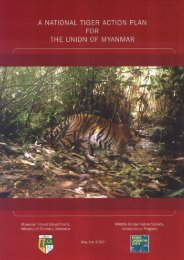Thailand Tiger Action Plan - Global Tiger Initiative
Thailand Tiger Action Plan - Global Tiger Initiative
Thailand Tiger Action Plan - Global Tiger Initiative
You also want an ePaper? Increase the reach of your titles
YUMPU automatically turns print PDFs into web optimized ePapers that Google loves.
<strong>Tiger</strong>s moving through an area usually leave overt and distinctive evidenceof their presence including tracks, scrapes, and claw marks on trees.<strong>Tiger</strong>s also spray urine on trees and deposit urine and feces on the ground(usually in association with visibly distinctive hind paw scrapes). Thesescent marks leave an unmistakable odor that may last for several days.Together, these visual and olfactory cues help tigers communicate theboundaries of their territory to other tigers and a range of other species(Smith et al. 1989).Of the many sounds a tiger is capable of emitting, the most likely to beheard is the awesome moaning, 'aa-oo-mh, aa-oo-mh', used during themating season. This call carries over considerable distances, attracting theresident male to the estrous female. Other vocalizations, which may beheard at close range, include low growling, snarling and coughing grunts.The roar of a tiger is unforgettable in any circumstance.When tigers mate, they usually remain together for 2 to 5 days, copulatingevery 15 to 20 minutes day and night. After 102 to 105 days, the femaledens in dense vegetation and produces on average 3 cubs. During the first2-3 days after birth, the female remains at the den for up to 23 hours aday; she gradually leaves for longer periods until the den is abandonedwhen the cubs are about 2 months old. For the next 2-3 months, thefemale moves the cubs from place to place, but they still remain hiddenmost of the day.Until the cubs are several months old, the cubs go to a kill only after theprey animal has been dispatched by the mother (Smith 1993). By six toseven months of age the cubs begin to accompany their mother on hunts,but the final stalk and kill is by the mother alone. At 11-13 months thecubs’ milk canines begin to protrude, pushed out by the emerging adultcanines that are fully erupted at 16-17 months. Even though they have the“equipment” to kill prey at this point, young tigers require 2 to 3 additionalmonths to learn to kill efficiently on their own. During this time, theygradually become independent from the mother, but continue to huntwithin the security of her territory. During the years of her life when she isreproductively active, a female will typically give birth from 19 to 24 monthsafter her previous litter is born. Two months later, when she and the cubsabandon the den site, aggression between the female and her previouslitter marks the onset of dispersal of the older offspring. The young leavethe territory where they were born and raised and face the most criticalperiod in their lives over the next few months of early independence.Approximately 60% of young males and 40% of females die during thisdangerous dispersal period (Smith 1993).<strong>Tiger</strong>s are territorial. Females protect their area from others of the samesex; males, which have territories overlapping those of 2-7 females, dolikewise. Dispersing young face a gauntlet of resident animals guardingtheir territories and are often forced to reside temporarily in suboptimalhabitat at the edge of protected areas where they may come into conflictwith humans and their livestock. For females, the dispersal stage usuallylasts about 1 year. About 40-50% of daughters settle next to their mother,who will often shift her territory slightly to accommodate a daughter.
















